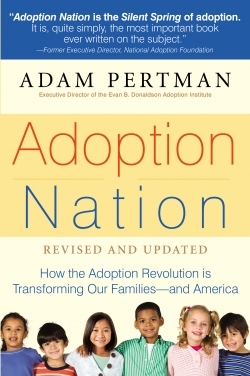Adoption Nation
How the Adoption Revolution Is Transforming Our Families—and America
Angelina Jolie, Sandra Bullock, and Hugh Jackman all bravely bring something once hidden into the light: adoption. They aren’t alone. Celebrities who proudly adopt mirror a transformation underway in our neighborhoods, schools, and families. Adoption, seemingly out of the blue, appears everywhere—in the news, at the playground, in schools, at church, and in our own families. Something is changing. And according to author Adam Pertman and his book Adoption Nation, it’s nothing short of a revolution.
Until very recently, adoption remained secretive. Birth mothers feared the stigma of out-of-wedlock pregnancy, adoptive parents wanted a “normal” family, and adopted children were thought to be better off not knowing. International adoption was nearly non-existent, as was adoption by single parents, same-sex partners, and disabled men and women. Today, all of that has been turned on its head. And the changes continue at a rapid-fire pace.
Adam Pertman—a Pulitzer Prize-winning journalist, the Executive Director of the Evan B. Donaldson Adoption Institute, and an adoptive father himself—explores these changes. Divided into chapters discussing legal issues, various types of adoptions, and the perspective of each member of the adoption triad (birth parents, adoptive parents, and the adopted child), his book explores the hot-button issues and the day-to-day realities of adoption.
Pertman explores the legal and social history of adoption, including the reasons for secrecy and why that is changing. He also considers the personal and emotional issues adoption raises and social trends currently fueled by changes in adoption. The most significant: adoption is getting more and more open. This is true within individual families and in our nation as a whole.
In individual families, birth mothers now enjoy greater rights than ever with more involvement in their children’s lives, and families with adopted children are discovering a new kind of “in-law.” On a grander scale, our culture embraces different family structures like never before: interracial families, single-parent households, and same-sex parents. And adoption is helping fuel these changes in society at large.
Pertman considers these trends and what they mean for adoption today and in the future. He argues that while many, especially openness, are positive, the impact of some is yet to be seen. He states that there is still a long way to go before some long-held beliefs, even prejudices, about adoption disappear. And he shares his views on how to encourage even more positive change.
While much of this may seem philosophical, the book rarely reads as such. It maintains a warm, almost intimate tone. Abundant personal stories make the issues real and connect with readers. The book also includes a lot of practical advice, much simply gained through understanding the issues. The book is sensitive. For example, Pertman reveals adoptees deep need for a life history saying, “This notion of coming from another planet permeates the self-description of adoptees of all types and ages.” Yet he fearlessly tackles tough issues, saying, for example, that while increased foster adoption is wonderful, politicians “haven’t yet sufficiently accounted for the long-term supports and psychological help that hundreds of thousands of new parents now require.”
A caveat should be borne in mind. The book promotes a strongly pro-openness perspective, which leads to two important notes. One, the perspective of adoptive parents who shy from openness could be explored more deeply. Adoptive parents should be aware this feels one-sided. And two, the promotion of open adoption resonates on almost every page, regardless of the topic discussed. It would be nice to consider many of the worthwhile issues without encountering this agenda at every turn.
Having said that, this book offers vital information for any parent wanting to adopt. At the very least, it offers much that must be considered beforehand. It also helps them, along with birth parents and adoption industry workers, to understand the larger picture. And, it can help friends and family members of birth parents and adoptive parents comprehend their loved one’s choices. It’s an essential read for adoption workers, potential adoptive parents, and extended family members touched by adoption. And it’s enlightening to anyone fascinated by how the social structure of our nation’s family is changing seemingly at the speed of a baby’s first heartbeat.
Reviewed by
Diane Gardner
Disclosure: This article is not an endorsement, but a review. The publisher of this book provided free copies of the book to have their book reviewed by a professional reviewer. No fee was paid by the publisher for this review. Foreword Reviews only recommends books that we love. Foreword Magazine, Inc. is disclosing this in accordance with the Federal Trade Commission’s 16 CFR, Part 255.

